This 1925 photo shows a gravel road, which was to later become Highway 36, winding into the town. Unless otherwise noted, all photos courtesy Jessie Wheeler, via the Humboldt Historian.
###
As its name suggests, Bridgeville has been defined by the four bridges that have spanned the Van Duzen River and the town’s 120-year-plus history. The remote community, which lies about fifty miles from Eureka, owes its very existence to its crossroads location.
Before 1875, when the first bridge was built, people crossed the Van Duzen River at a place known as Robinson’s Ferry after local rancher and early settler William Slaughter Robinson. Even though the river was narrow at the crossing, fording the swift water was a risky struggle. This limited the horse-drawn traffic of that day to low-water conditions in the summer.
According to historian Owen Coy (The Humboldt Bay Region, 1850-1875), Humboldt County residents had been agitating for a road to Mendocino County for more than a decade before the bridge was built. In 1874, after much discussion, Humboldt County supervisors authorized construction of a road from Kneeland Prairie and Yager Creek south over the open hills to the county line.
Coy states, “By June 1875, the road had been built from Kneeland Prairie to a point past old Camp laqua, while the Van Duzen River had been bridged at Robinson’s ferry.”
To mark its new status, residents called the town Bridgeport. A report printed in the West Coast Signal on February 14, 1877, describes the town:
Another one of the attractive localities on the nearly completed overland road is the new town of Bridgeport, situated at the crossing the Van Duzen River, and the junction of the Humboldt and Mendocino and Kneeland’s Prairie Roads. By those who have visited Bridgeport in the spring, summer or autumn, it is pronounced to be one of the pleasantest retreats in the county, and the region round boasts an abundance of wild game and fish.
The property adjacent to the bridge is owned by Mr. John J. Hale, and we are informed on good authority that Miller, Sweasey and Co., proprietors of the Humboldt and Mendocino Mail Stage Line, have leased the hotel stand and will make Bridgeport one of the eating and change stations on the route. In the hands of an expert in the hotel business, the Bridgeport House will soon become a popular place of retreat.
In May of 1877, when the post office was established, it was found that a town in Mono County had already claimed the name of Bridgeport. Residents searched for a new name, and the town promptly became known as Bridgeville.
Bridgeville before the fire of 1919. From left, the hotel, barn, and general store, which were all destroyed in the fire.
Not quite four years after it was built, the first bridge, said to have been weakened by decayed posts, collapsed in a late-winter torrent of high water. The March 1879 tragedy claimed one life, that of young Johnney Hale.
The boy was the son of John Hale, an early settler who had built the twenty-four-room Bridgeville Hotel, a two-story structure that was later lost to fire in 1919. He also acted as postmaster, and owned the other buildings in town.
On the day of the tragedy. Hale, along with some other men, had been monitoring the high waters around the bridge most of the day. His son, who had been watching from the apparent safety of the bridge, was drowned when the entire structure suddenly washed into the river. Another of Hale’s sons and two men were likewise dropped into the river, but survived. Johnney’s body was recovered twelve miles down river and he was buried in Bridgeville Cemetery.
To avoid another washout and the potential for future tragedies, plans were laid for a new bridge high enough to avoid a similar problem. Key to its support were two sturdy, above-deck wooden arches that stretched across the river to firm supports on either bank. The deck, along with the hand- fashioned arches, was enclosed in the classic covered-bridge style to protect the bridge from the elements. The covered bridge, completed in 1879, lived up to its expectations and served the community well into the era of the auto.
The old covered bridge was built in 1879 after the first bridge washed away, drowning a young boy. This photo, taken when it was being dismantled in 1925, shows a portion of the long, wooden arches that extended from shore to shore to support the bridge.
Ed Barnum was the next proprietor of the town, having purchased the store and land from Hale. A printed clipping from the Susie Baker Fountain Notebooks, identified only as “Aug. 1882?, ” states:
A news ‘“brief described the town of Bridgeville: “Bridgeville is now about one of the liveliest places in the county. E.B. Barnum, owner of the place, has quite a little town of his own. He resides there with his family, keeps a hotel, store and the post office. There is also a blacksmith and a harness shop and a Good Templars lodge located on the premises.”
Another description of Bridgeville. published in 1881 by W. W. Elliot in The History of Humboldt County, California, gives a slightly different impression:
This town, situated on the Van Duzen, is some twenty-five miles east of Hydesville. It has two hotels, blacksmith shop, store and a few dwelling houses, and has an air of thrift. Nature has done her part toward making this place most favorable for spanning the stream. The river is narrow, the banks high, and large rocks put on either side, forming perfect buttresses, from which the bridge rises in a graceful arch far removed from the dangers of high water.
This early store was operated by Ed Barnum. Henry Cox bought the store and town from Barnum’s estate in 1912.
The town’s next owners, the Cox family, came to Bridgeville in 1909. Nova Scotia native Henry Cox and Maria Jane Coffren had been married in Bayside. After moving to the remote inland community, Henry ran the Bridgeville Hotel for several years, and then, in 1912, acquired the entire town from the estate of Ed Barnum for the reported price of $15,000. At this point, before the railroad from San Francisco to Eureka was put through in 1914, Bridgeville continued to be an important stop on the road from the south. Also, the new highway east to Red Bluff had been completed, and Henry thought that when people from the Sacramento Valley began 10 travel westward to the coast that Bridgeville would become a major stopping point.
Of Henry’s seven children, six eventually moved on to other locales. One son, George Henry, lived the rest of his life in the small community, and has descendents living there today. Born in Bayside in 1889, George Henry attended Eureka Business College, frequently referred to as Craddock’s Business College after its principal, then joined his father in running the general merchandise store. The store, a neatly painted white structure in the center of town, was identified with a sign that read “Henry Cox & Son,” and in case travelers didn’t know where they were, large letters near the top of the two-story building spelled out BRIDGEVILLE.
George Henry Cox saved hundreds of documents from store transactions, including correspondence. These not only give valuable insights on the commerce of the day, but highlight the personal service, often above and beyond the call of duty, that Cox rendered to the townspeople. He helped many of them, a number of whom were illiterate, with minor legal chores like filling out forms or preparing documents. To ease the hardships of their remote location, he did his best to fulfill the many special requests that arrived daily from in-town and outlying customers.
He also gave generously to the community. He purchased trout to plant in the Van Duzen River to enhance the fishing for townspeople, and each Christmas he decorated a large evergreen tree with lights on his property near the center of town.
The correspondence shows that the Coxes were not bashful when it came to addressing wrongs. A letter offers insights on how they approached problems:
July 18, 1916
The San Francisco Bulletin
R. A. Crothers, editor and proprietor
Dear Sir:
In your issue of the Bulletin dated July 14, 1916, you published an article entitled Humboldt Highways by Virginia Ballen.
This article contains the vilest slander and the most deliberate falsehoods we have ever seen published relative to any place. We cannot conceive what Virginia Ballen’s motive could have been for writing such an article and we did not believe it possible that any paper would publish such slander.
There is not a single word of proof in the whole statement as regards Bridgeville. Bridgeville has no saloons. There is not a saloon within 20 miles of here and there has not been for 10 years or more. There is no gambling in Bridgeville and no ramshackle buildings. We believe it is one of the prettiest summer resorts in Humboldt County and you can readily see the damage this article will do to our business.
We enclose you late photographs of hotel and store at this place so that you may see for yourself. We shall expect you to make suitable amends for the article published at once. Please let us hear from you without delay.
The Coxes also helped fellow storekeepers from other towns. This letter of January 25, 1922, from the nearby town of Carlotta, obviously responds to a message that had been sent earlier:
Gentlemen:
We are glad to receive some encouragement that the Spingath Brothers may be located, because they owe us over $200 and if we can get a stranglehold on them we intend to hold fast until they come through.
Please keep us posted and greatly oblige.
Very truly yours,
Carlotta Store
The Cox family had more challenges than those of the pen. In December 1919 disaster occurred when their hotel and store both burned on a frosty morning. They quickly converted an old saloon and blacksmith shop into a store, which they operated together until the elder Cox died in 1934.
Bridgeville’s third bridge, and its first made of concrete, was built in 1925. Still existing, but used for pedestrian traffic only, it was designed by the same man who designed Fernbridge. Photo by Jack Silvey.
In 1925, after 46 years of service, the covered wooden bridge was torn down and replaced by the town’s third bridge. The new concrete span was designed by John Leonard, the noted engineer who pioneered the used of reinforced concrete in bridge construction. Another outstanding example of his work in Humboldt County is the Fernbridge, built in 1911, and long regarded as remarkable for its size, beauty and durability.
Construction of the third bridge roused considerable curiosity from George Henry’s eight-year-old daughter, Laura June. Each day she would perch near the site and watch employees of Mercer-Fraser Company do their jobs. Her presence became so integral to the project that when the arched, open-rail bridge was near completion, crewmen let her embed her footprints in the span beneath the pavement.
Through the years, children have continued to draw pleasure — and challenges — from the bridge. It became a rite of passage to walk the length of the bridge on one of its narrow concrete rails. Those who were daunted by the long drop to the roiling, boulder-strewn Van Duzen River were branded as cowards. Another common practice was to pretend to fall from the bridge, startling passersby who didn’t know there was a flat rock just below that offered a safe landing.
The third bridge stood witness to many changes in the town. In 1966 George Henry Cox died at the age of 77. Ownership of the town passed to his daughter, Laura June Cox Pawlus.
Pawlus, who served as Bridgeville’s postmaster for twenty-seven years, was interviewed by the late Andrew Genzoli for his column, “Redwood Country.’” Excerpts from the column, which was printed in the Times-Standard on April 29, 1977, follow:
The postmaster is an historian in her own right and says the first pioneers found a beautiful, unnamed valley along the banks of the Van Duzen River … As the community grew, there became the need to communicate with the outside world and the necessity for a good mail service. Humboldt County was so isolated by mountain ranges, most of the mail arrived by sailing or steam vessels at Humboldt Bay or by pack train over the mountains, weather permitting. A wagon road was needed to link the developing towns throughout the back country …
John Carr, using Chinese labor, constructed a road from Hydesville through Cuddeback [now Carlotta], Bridgeport, Blocksburg, Bell Springs, Cummings and eventually extending south to Cloverdale … Henry and Maria J. Cox purchased the Bridgeville Hotel which housed the post office … Maria Jane Cox became postmaster from May 4, 1910, until it was transferred to M. Lou Ballard. In 1912, George Henry Cox, son of Maria and Henry J. Cox, purchased the rest of the town of Bridgeville in partnership with the senior Cox family. George assumed the position of postmaster and served until 1955, except for an eight-year period when his partner in the grocery store, George F. Normale, held office.
Upon her father’s retirement in 1955, Laura June Pawlus became postmaster, a position she held for twenty-two years. With her retirement in 1977, the Cox family had attended to the postal needs of the community for more than fifty-four years.
Pawlus sold the town for $150,000 in 1973 to Elizabeth Lapple of Los Angeles, who felt the need to escape the pressures of the city with her two sons and move to a more serene environment. Their move coincided with a four-year “Hippie” invasion and drug scene with an attendant increase in problems and a general decline of the town.
Several years after she purchased it, Mrs. Lapple put the community up for sale. The Rev. A. M. Stevens of Fremont, who had founded a religious corporation called Faith Challengers, purchased the site from the Lapples in 1977 for $450,000. Stevens and his group planned to operate the town as a retirement home for the elderly.
He had trouble from the start, however, finding enough money for the down payment. In addition, he ran into difficultly with the Humboldt County Health Department when he tried to repair some of the long-neglected old buildings in town.
Meanwhile, the sale and purchase of the town had attracted nationwide media attention, including that of the wire services and publications, including the New York Times and Time Magazine. An article from June, 27, 1977, in Time, recounts how Stevens and his religious group became involved:
“I was riding down the freeway when I heard on the radio that this little place I’d never heard of was for sale, and the Lord made it known to me that this is where we should go and do his work.” The little place that the Rev. Alvin Stevens heard about was the entire town of Bridgeville, all 80 acres and 25 buildings of it.
Stevens sped 330 miles north of San Francisco for a look and immediately fell in love with the region, its mist-shrouded forests and trout-filled streams. This would be an ideal spot to raise families, Stevens decided, and to care for the elderly poor, who “live worse than hogs many places …”
Stevens, 48, a onetime construction worker from Oklahoma, took his dream to the folk at Stonybrook Full Gospel Temple in Fremont, a Pentecostal church that he had scraped together. After a prayer meeting, five of the 70-odd parishioners agreed to sell their houses to make up half the down payment. Last week 48 church members arrived at their newly bought Eden and found, as often happens with Edens, that the place was a mess. .. . Bridgeville had turned into a rural slum in the middle of God’s country. Wrecked cars now lie forlornly about. The main water system and septic tanks are broken, as are the toilets in apartments underneath a sagging dance hall …
The parishioners, who set up a three-member town board, have the skills to rebuild the place, explains Stevens. A store and restaurant will raise capital. The refurbished Country Cafe is already open, complete with no-smoking signs, five paintings of Jesus and delicious homemade pies.
With church people in town and beer banned, the hippie families who remained were exiting “as soon as we can find another place to live this cheaply.” For them, the attraction of Bridgeville had ended. The townspeople were pleased to see the improvements but the dream collapsed under the weight of the financial burdens. Then along came Don Houston, head of another religious organization called Visions for Missions, Inc. from San Jose. He purchased the town from Stevens just before Elizabeth Lapple, the former owner, could complete foreclosure. He came up with $80,000 — enough to swing the transaction.
A story in the Humboldt Beacon of Feb. 8, 1979, by Willie Knapp, described the latest turn of events this way:
Houston’s organization appears to have some clout behind it and the initial plans he has for the newly acquired town seem grandiose at this time …
He is planning to spend about $ 1.5 million the next year or so to turn the sleepy town into a throbbing re.sort area. Plans have been discussed that include a 4-unit motel and coffee shop, a restaurant and dinner house, a general store, a 30-unit RV park, three 12-unit condominiums, a health care and medical service center, a public water system, a Christian Service Center, an industrial parts assembly plant and light industrial facilities …
However, there is one important part of the planning project that must be completed before all other buildings can start. And that is the installation of a sewer system for the town.
Rev. Stevens stayed in town and Houston paid him five hundred dollars per month to help with the new project. This arrangement was brief because the two pastors went separate ways when Houston insisted on plans to sell alcoholic beverages and cigarettes in the cafe and general store. Stevens was strongly opposed to these items, and had kept them off the shelves during his tenure of leadership. He left town, leaving some burning questions behind. Like: What happened to the money collected by Stevens and his group for a raffle of a 1978 car? Did that raffle ever take place? Was it used to meet the debt obligation like the religious group said it was? And what about the elderly who had invested their life savings and were left destitute?
After working on his grand plan for about four years, from 1978 to 1982, Houston, like his predecessor, ran into financial problems and he tried to sell the property. There were no takers and the town ownership reverted back to the Lapples. With the death of the elder Elizabeth Lapple, her daughter, Elizabeth, became the owner, and remains so today. [UPDATE from 2025: No longer. The town is owned by the estate of Daniel La Paille. Wikipedia is up-to-date, so far as we know.]
Now, the only business in Bridgeville is the post office. The store and the cafe are gone. The post office, together with a public elementary school, community center and state fire station, keep the community spirit alive. Because many people live in areas beyond the town, it is difficult to arrive at a population figure. A highway sign says 300, the school enrollment is near 100 and the post office, covering such widespread areas as Bridgeville to Ruth by motor route, serves an estimated 400 to 500 patrons. One resident’s educated guess is that the town population is about 50.
Producers of the 1938 film Valley of the Giants had this dam built on the Van Duzen River in Bridgeville. It was blown up for a climactic scene. The movie starred Wayne Morris, Claire Trevor and Charles Bickford. Leonard Maltin’s film guide says the movie deals with “Bickford’s attempt to rape Northern California of its redwoods, with saloon girl, Trevor, brightening the proceedings.”
Today, except for the old bridge, the only prominent reminder of the past as you drive into Bridgeville is the large barn built in the early 1900s and first used as a livery stable for the pack trains and stage lines. Since about 1920 it has been used for a number of different functions including a garage, recording studio and storage area.
In 1997 a chapter ended in the life of the town’s third bridge. After Caltrans decided it was necessary to build a new bridge, the old one was closed to vehicle traffic. Now listed on the National Register of Historic Places, the graceful old bridge is used only by pedestrians. On a warm summer day voices can be heard drifting up from below the span as townspeople enjoy a swim in one of several swimming holes along the river. During the town’s annual celebration, “Bridgefest, ” booths and other attractions appear on the bridge deck.
The time-honored bridge will witness another chapter in Bridgeville history, just a short distance downstream, in August 1999 when the town’s newest span and fourth bridge, which opened to traffic in 1997, is dedicated to the memory of George Henry Cox, a longtime civic leader and merchant in Bridgeville. The dedication will be part of the Bridgefest celebration.
The Cox family, with George Henry driving, enjoying a picnic with friends.
Faster, wider and longer than the third bridge, the latest structure was built over a five-year period at a cost of six and a half million dollars. According to Jessie Wheeler, the daughter of Laura June Pawlus and the granddaughter of George Henry Cox, only private funds will be used to finance the bridge dedication, including the placement of a marker that pays tribute to George Henry Cox. A fund has been set up at Coast Central Credit Union in Fortuna for deposit of donations for the project. The name of the account is the George Henry Cox Memorial Dedication Fund.
Jessie Wheeler, a Bridgeville native and longtime resident, says she has seen the town emerge from a “terrible state of depression” into a community with pride and a sense of direction. She feels this has been largely made possible by a grant from the “Healthy Start” program, which makes funds available to launch improvements. Among other projects, the grant has allowed purchase of a van used to transport school children in remote areas from their homes to a school-bus stop, a task that some parents find difficult with the result that school attendance dropped off. Other evidence of the town’s rebirth is the establishment of a community center, a senior lunch each Thursday with an attendance of fifteen to twenty people, the annual Bridgefest community celebration, a Fourth of July party, and ice cream socials, which all enhance a sense of community.
###
Author’s note: Credit goes to the following for some of the information and insights used to compile this article: Jessie Wheeler, Jennifer Hawley, Don Tuttle, Evelyn Shuster Worthen ‘s book, The Unfolding Drama of Bridgeville, A Former Stagecoach Town, and the staff at the Humboldt County Historical Society.
###
The story above is excerpted from the Winter 1998 issue of the Humboldt Historian, a journal of the Humboldt County Historical Society. It is reprinted here with permission. The Humboldt County Historical Society is a nonprofit organization devoted to archiving, preserving and sharing Humboldt County’s rich history. You can become a member and receive a year’s worth of new issues of The Humboldt Historian at this link.
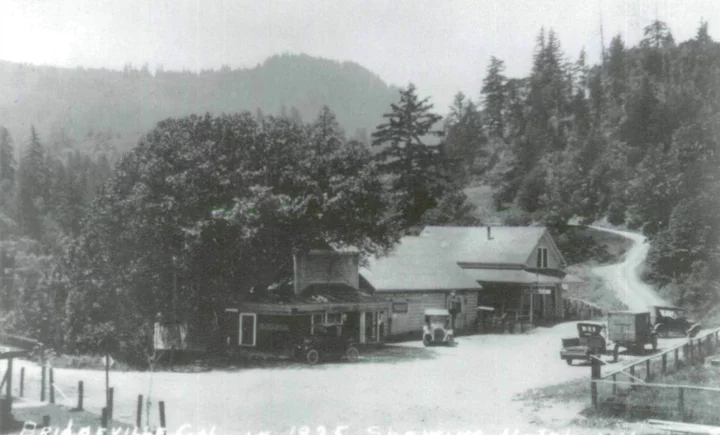

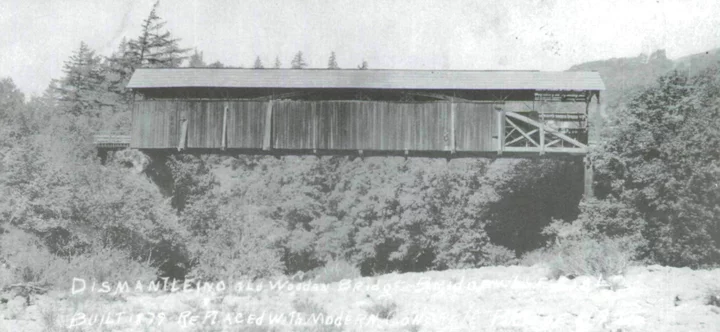
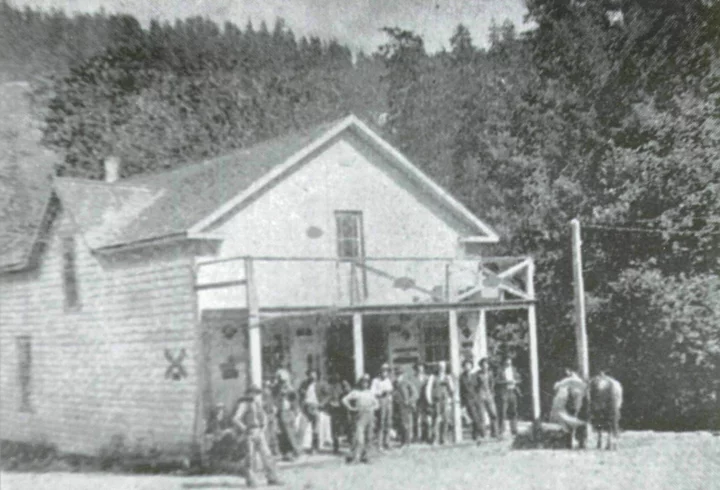

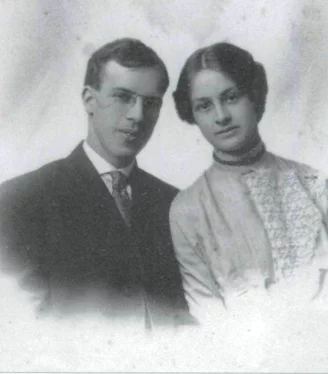
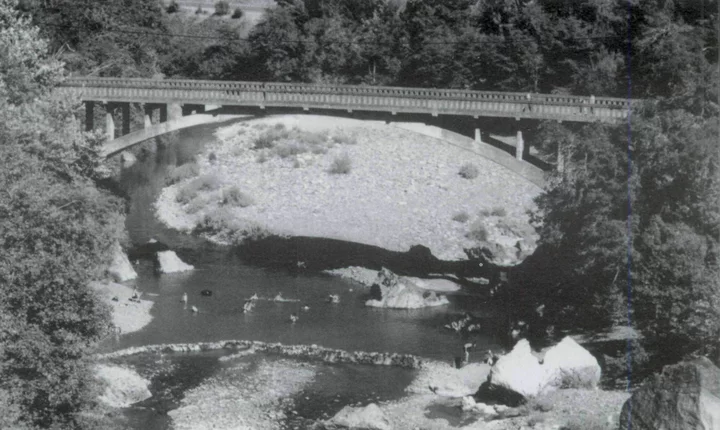
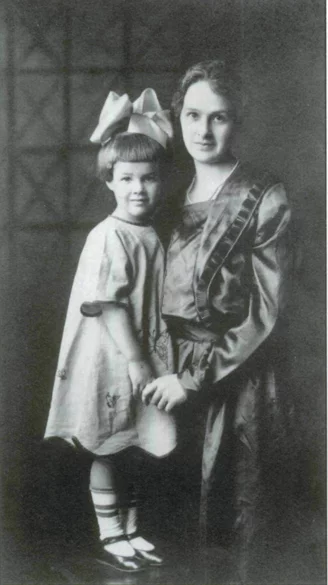
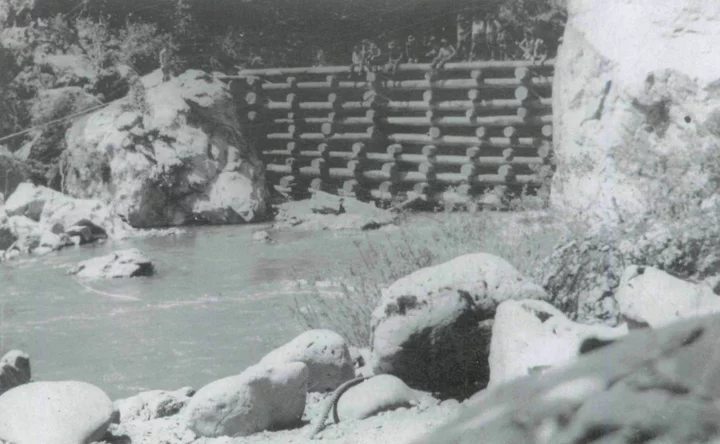

CLICK TO MANAGE